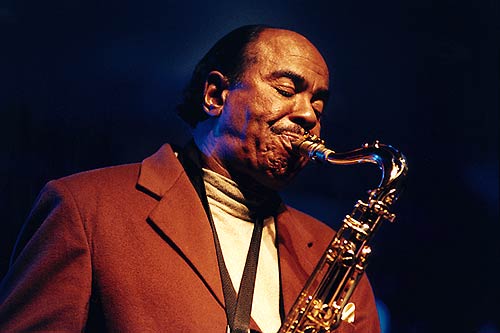
 Benny Golson |
|
Story by Jean Timmons
As if to carefully ease the audience into a night of jazz music, Miller opened with the old chestnut "A Sleeping Bee," a very lyrical piece, which Miller sang beautifully via his piano. He was so enthralling, with cascading Oscar Peterson-like passes, that one did not hear the other members of the trio until well into the music. Then the bass took on an involved solo, on top of old sleeping bee. Next, the energetic drummer made his presence known in sharp contrast to the other members of the trio. After this musical introduction, gracious Mulgrew spoke to the audience about the honored guest, referring to Golson at one point as His Excellency. Then the trio played three classic Golson compositions: "Stablemates," "I Remember Clifford," and "Whisper Not." Each piece was thoughtfully arranged. "Stablemates"" was rendered at a fast, breezy pace. Unique in that it didn't sound like anything else, except for the hint, perhaps, of "Tangerine" toward the end. Mulgrew solos were distinctive, and the bass was resonant. The ballad "I Remember Clifford" touched on all the contours of a reminiscence. When Mulgrew played the ending solo, one is reminded of the reason this sweet remembrance of the beloved Clifford Brown has such long legs. "Whisper Not," another distinctive Golson piece, featured the marvelous brush work of the drummer, and Julliard-trained, Chicago-born bassist Taylor was outstanding as well.
In addition to his tenor, Golson brought his Jazztet: Eddie Henderson (trumpet), Steve Davis (trombone), Mike LeDonne (pianist), Buster Williams (bass), and Carl Allen (drums). They took the stage and immediately launched a little swinger called "Grove's Groove." After a short group statement, the trombonist played out front. Golson was laid back on this selection, as they all were content to swing in an understated way-relaxin' at Symphony Center. Terribly cool. Besides the writing and the playing, Benny Golson is a raconteur, and his introductions to the pieces were quite entertaining. He seemed to enjoy his stories and music along with the audience. It was intimate. The band followed the opener with Monk's "Epistrophy." From the first note, hit so emphatically to the roll of the drums, it was an excellent interpretation. Ever the band leader, Benny strolled the stage, pausing near members of the band to catch the intricacies of their improvisations.
The final piece returned to straightahead jazz. Another Golson original composition, it was called "Uptown Afterburn" and was reminiscent of "Killer Joe." With this one, the bass set the pace and Golson blew hot on it. Much camaraderie on that stage for all to see. The night revealed an artist who has lived through many phrases of jazz, and his music reflected so much change. He is so dynamic, which was great for an audience to experience in a person of his age and stature. On this night, there had to be an encore. We patiently waited until the drummer walked back on stage alone. He sat at his workbench and began establishing a rhythm that was a call to his compadres to join him for a little "Blues Walk." And so everyone marched along. |